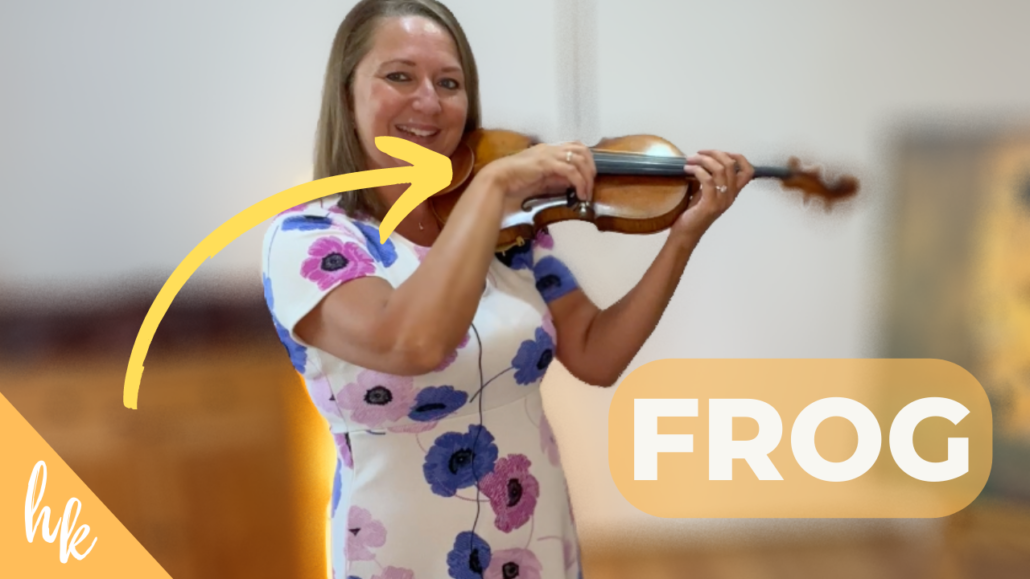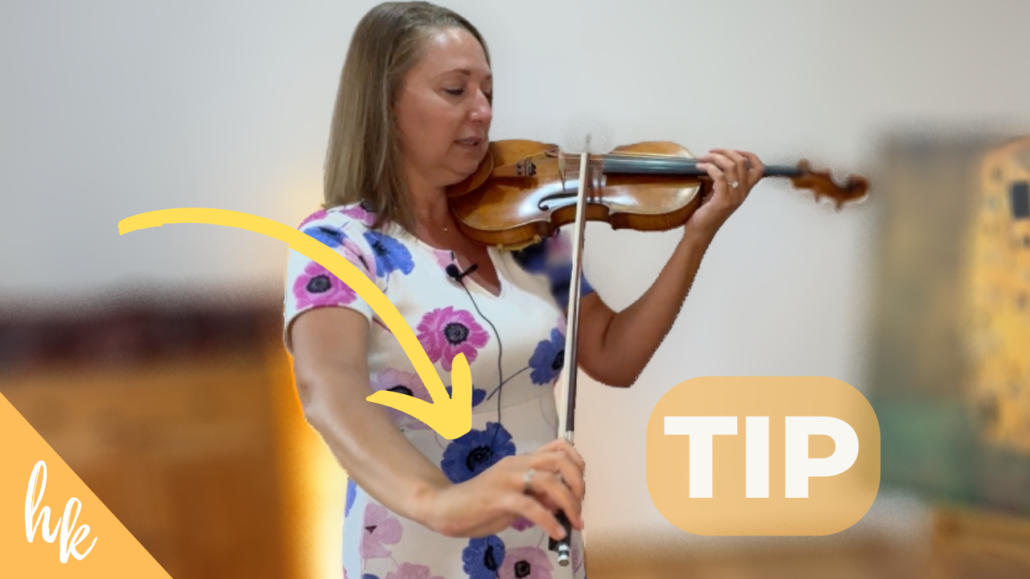Violin Bow Wrist Movement
Don’t Want to Read? Watch the Video!
Confused with the role of the wrist in your bow arm? In this post, discover the optimal violin bow wrist movement and exercises to cultivate that motion.
Let’s discover the role of the wrist in the bow arm. We really want the wrist to be supple and flexible no matter where we are in the bow.
Always ask yourself, what does the bow need to do and how do I need to be in order for the bow to operate naturally and effectively. Instead of thinking about what you need to do, think about what the violin needs you to do.
With our wrist as an example, if we play whole bows with an inflexible straight wrist, they will be very crooked bows. Plus the accuracy of playing only on one string diminishes.
Find yourself hitting other strings as you play? Check the operating procedure of your wrist.
How the bow wrist behaves also helps with smooth bow changes whether that occurs at the frog or at the tip.
So let’s break it down with the different parts of the bow.
Bow Wrist Movement, Mid-bow
In the middle of the bow, we want to have wrist flexibility. In the middle of the bow, it’s a very subtle motion but it is there. We don’t want the wrist to be locked up. If the wrist is locked up, the tone will sound very beginner-esque.
For the most part, violinists feel pretty comfortable in the middle of the bow without too many issues. It’s when we get to the extreme parts of the bow that the wrist has more influence on what’s going on than in the middle of the bow and this is why a lot of violinists are very uncomfortable at the frog or the tip because the wrist really does need to change in a dramatic way.
Bow Wrist at the Frog
If we play with a straight wrist at the frog, it’s going to be very difficult to pull out a beautiful tone. An inflexible wrist pulls out a scratchy sound.
It’s very imperative that while we play at the frog, we have a nice hill in the wrist. The relaxed right hand is suspended from the wrist. Discover this feeling while playing at the extreme frog.
While at the frog be sure your bow hold pinky is curved and a nice dropped relaxed elbow. We don’t want to have a high elbow but a nice relaxed elbow which puts a nice curve in the wrist.
Bow Wrist at the Tip
As you pull a down bow, the hill in the wrist starts to straighten out. As you travel to the upper half, you start to get what I call a smile in the wrist.
Be sure to check out my, What is a Balanced Bow Hold and Why Is It Important blog post for this instruction to be super effective and productive. It is a must to be aware of the balance in the bow hold as you explore the role of the wrist.
Bow Wrist Movement Exercises
1.Place your bow to the violin at the frog.
2. Notice the hill in your wrist while feeling relaxed in the shoulder and elbow. Feel as if the violin is holding up your relaxed bow arm and bow.
3. Take the bow slightly off the string and travel to the tip without playing. Set the bow down again at the extreme tip. Notice the smile in your wrist.
4. Take the bow slightly off the string and travel to the frog without playing. Set the bow down again at the extreme frog. Notice the hill in your wrist.
5. Repeat and watch that the bow travels in a straight line.
The wrist helps you to be comfortable in these two extreme parts of the bow and so extreme tip.
When you do this exercise we want to get all the way to the very, very extreme tip. This is a good exercise to do to discover how the wrist changes from the frog to the tip.
Bow Wrist Movement Scales
1. Play scales at the extreme frog with only a few inches of bow, being aware of the hill in your wrist.
2. Play scales at the extreme tip with only a few inches of bow, being aware of the smile in your wrist.
Bow Wrist Movement Whole Bows
1. Pull beautiful long whole bows on open strings from the frog to the tip.
2. Watch that the wrist is flexible and transforms from a hill to a smile and reverse.
3. Be aware mid bow the wrist does indeed straighten out in the middle of the hill/smile, smile/hill transformation.
4. On the up bow as you arrive to the lower middle, feel as if somebody or something is actually pulling a string attached to your wrist to get you to the frog. Exactly here in the lower third of the bow, we want to feel that the hand is actually hanging from the wrist.
Be careful that it’s not the hand that’s controlling this motion like purposely hanging, it’s actually a relaxed hand that’s hanging from your wrist.
5. While at the frog take your left hand and remove the bow away from the right hand. Your right hand should actually be just hanging from the wrist.
6. Bring your bow back to the right hand and feel how the hand is hanging from the wrist.
Bow Wrist Movement Exercise Without the Violin or Bow
1. Discover the weighted feeling without the bow. Take a tennis ball or something else round with weight. Air bow with a relaxed hand hanging from the wrist. Remember to keep a hill at the frog and a smile in the wrist at the tip.
2. As you do this, you want to feel that your shoulder is staying relaxed and not coming up okay. Just feel like you’re really elegant with the motion of the bow arm so you can get a feeling of how this works just muscularly without any instruments or bow.
3. Repeat the same motion with the tennis ball as you hold the violin. This way you just activate the left side of the body holding the violin as you feel that motion of the wrist.
4. Replace the ball with the bow and air bow frog to tip, back to frog on every string without feeling your shoulder tensing up.
5. Bow long straight bows being aware of the wrist motion. On the up bow, be sure to return to the hill in the lower middle to the frog. What I have found is that violinists actually struggle to return to the hill at the frog. On the up bow lower half, lead with the wrist and allow the hand to be suspended from the wrist.
If you enjoyed this post and you would really desire to have more training from me in a step-by-step program to improve your violin tone, definitely check out my 12 week signature program, Gorgeous Tone Academy where you’ll find exercises, tutorials on a daily basis to get you where you want to be.
It’s a completely self-guided online program that you could start at any time. I’d be happy to see you there.
Happy Magical Practices,
Heather is a classically trained concert violinist residing in Bulgaria. She received her BM violin performance degree from CU-Boulder, studied with top teachers including Rachel Barton Pine. Heather has held leadership positions with multiple orchestras in the Greater Chicago-Milwaukee area. She has instructed millions of violinists globally via Youtube videos, online academies, group coaching and one on one sessions. Heather’s students have won multiple awards, concerto competitions, held concertmaster positions in orchestras and even performed in Carnegie Hall. Heather is an advocate of a holistic violin lifestyle – putting one’s mind, body and spirit as a violin journey priority.
Please share in the comments which above tips you will be implementing into your daily practices sessions.








Leave a Reply
Want to join the discussion?Feel free to contribute!